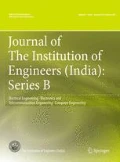Abstract
India, having less awareness towards the deaf and dumb peoples leads to increase the communication gap between deaf and hard hearing community. Sign language is commonly developed for deaf and hard hearing peoples to convey their message by generating the different sign pattern. The scale invariant feature transform was introduced by David Lowe to perform reliable matching between different images of the same object. This paper implements the various phases of scale invariant feature transform to extract the distinctive features from Indian sign language gestures. The experimental result shows the time constraint for each phase and the number of features extracted for 26 ISL gestures.














Similar content being viewed by others
References
G.R. Sinha, S. B. Patil, Biometrics: Concept and Application, Wiley India Pvt. Ltd (2013)
V.J. Arulkarthick, D. Sangeetha, S. Umamaheswari, Sign language recognition using K-means clustered Haar-like features and a stochastic context free grammar. Eur. J. Sci. Res. 78(1), 74–84 (2012)
J. Alon, V. Athitsos, A unified framework for gesture recognition and spatiotemporal gesture segmentation. IEEE Trans. Pattern Anal. Med. Intell. 31(9), 1685–1699 (2009)
M.K. Bhuyan, M.K. Kar, R.N. Debanga, Hand pose identification from monocular image for sign language recognition, IEEE international conference on signal and image processing applications (ICSIPA2011), 3(12), 378–383 (2011)
G. Balakrishnan, P.S. Rajam, Real time Indian sign language recognition system to aid deaf-dumb people, IEEE international conference on computing communication and networking technologies (ICCCNT), 737–742 (2011)
P. Chakraborty, S. Mondal, A. Nandy, J.S. Prasad, Recognizing and interpreting Indian sign language gesture for human robot interaction, Int’l conference on computer and communication technology |ICCCT’10|, 712–717 (2010)
S. Jothilakshmi, S. Palanivel, V. Ramalingam, A hierarchical language identification system for Indian languages. Digit. Signal Proc. 2(2), 544–553 (2012)
P.V.V. Kishore, P.R. Kumar, A video based Indian sign language recognition system (INSLR) using wavelet transform and fuzzy logic. Int. J. Eng. Technol. 4(5), 537–542 (2012)
P.V.V. Kishore, P.R. Kumar, Segment, track, extract, recognize and convert sign language videos to voice/text. Int. J. Adv. Comput. Sci. Appl. 3(6), 35–47 (2012)
M. Krishnaveni, V. Radha, Classifier fusion based on Bayes aggregation method for Indian sign language datasets. Proc. Eng. 30, 1110–1118 (2012)
A. Magdy, A. Samir, Error detection and correction approach for Arabic sign language recognition, ISSN 978-1-4673-2961, 3(12), 117–123 (2012)
U. Zeshan, M.M. Vasishta, M. Sethna, Implementation of Indian sign language in educational settings. Asia Pac. Disabil. Rehabil. J. 16(1), 16–40 (2005)
S. Majumder, J. Rekha, Indian sign language recognition with global-local hand configuration, IEEE 13th international conference on communication technology (ICCT), 27–33 (2011)
T.D. Nguyen, S. Ranganath, Facial expressions in American sign language: tracking and recognition. Pattern Recognit. 45(5), 1877–1891 (2012)
M.P. Paulraj, R. Palaniappan, S. Yaacob, A. Zanar, A phoneme based sign language recognition system using 2D moment invariant interleaving feature and neural network. IEEE Stud. Conf. Res. Dev. 2(11), 111–116 (2011)
A.S. Ghotkar, M. Hadap, R. Khatal, S. Khupase, Hand gesture recognition for Indian sign language, International conference on computer communication and informatics (ICCCI -2012), Coimbatore, India, 2(4), 9–12 (2012)
Y. Quan, Chinese sign language recognition based on video sequence appearance modeling, Fifth IEEE conference on industrial electronics and applications, ISSN 978-1-4244-5046-6/10:1537–1542 (2010)
A. Bhosekar, K. Kadam, R. Ganu, S.D. Joshi, American sign language interpreter. IEEE Fourth Int. Conf. Technol. Educ. 6(12), 157–159 (2012)
Author information
Authors and Affiliations
Corresponding author
Rights and permissions
About this article
Cite this article
Patil, S.B., Sinha, G.R. Distinctive Feature Extraction for Indian Sign Language (ISL) Gesture using Scale Invariant Feature Transform (SIFT). J. Inst. Eng. India Ser. B 98, 19–26 (2017). https://doi.org/10.1007/s40031-016-0250-8
Received:
Accepted:
Published:
Issue Date:
DOI: https://doi.org/10.1007/s40031-016-0250-8




